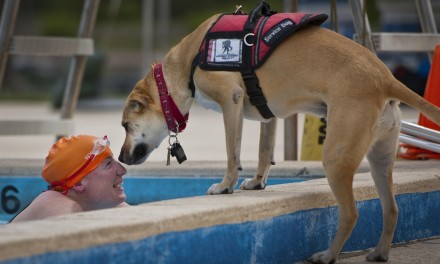Clickers are phenomenal tools in animal training because the sound they make is consistent and salient in the environment. When I say salient, I mean that almost nothing else in daily life makes such a distinct sound, thus the sound can carry tremendous meaning. However, to do this you have to make that particular sound mean something. I am going to break down clicker training into 3 parts.
Part 1: Charging the clicker!
To make the clicker effective we have to first understand the purpose of the clicker. The clicker is not some magical device that is used to get a dogs attention or carries some innate reinforcing function. The clicker is a marker to tell a dog, “THAT moment earned you a reward.” But a dog can’t know there’s a reward coming if he hasn’t been taught the pairing of “click” with “reward”. To teach this correlation you have to charge the clicker.
Naturally, step one requires you to buy a clicker and, ideally, a training pouch.
I recommend the Karen Pryor i-Click and the Terry Ryan training pouch.
Many clickers from PetCo or the like make incredibly loud noises that to a sensitive dog are quite scary. Most dogs do fine with the noisy ones but there are also many quiet clickers available on the market (the iClick developed by Karen Pryor is one of them). Dogs have exceptional hearing so it doesn’t make a difference whether your clicker is quiet as a mouse or as loud as a police megaphone, so long as the sound itself isn’t startling for your dog. When you go to buy one, I recommend taking your dog along and testing it out to see how he reacts, that way you don’t have to return it if they don’t like it. If your dog is startled by even a quiet clicker, you will instead be using a designated “marker-word” however this should be last resort. I have my dogs trained with both marker-words and clickers and the training is unequivocally faster with a clicker. (For marker-word users, scan down to the bottom to read on “choosing a marker-word”).
At this point you have either a clicker or a marker-word so from here on out I will refer to “marking”.
Next we have to charge the marker. For 3 days you are going to feed every meal by hand, one piece of kibble at a time. If you are using wet food, this might get a little messy but you will only have to do this process once so tough up and remember the supermarket sells hand-soap. Remember, we are training a dog to understand that a “mark” means they earned a reward. Do not ask for any more criteria once you have marked! Many owners want eye-contact before dishing out the reward and doing so hurts the association we need the marker to have. If your dog is not sitting, or giving you eye contact, take the food and stick it in their nose. They will figure it out soon enough and we can use the marker to train an eye-contact command later, however at the moment we are still crawling (running and jumping comes later).
Here’s the process:
Measure out your dog’s meal into a bowl or training pouch.
“Mark” > feed one kibble
(finish chewing)
“Mark” > feed one kibble
(finish chewing)
“Mark” > feed one kibble
(etc. etc.)
Get the idea? This is a two-step process, X means Y so don’t mark and feed at the exact same time. We want the dog to hear the mark and then receive the reward. If your dog starts to get distracted during this process then end the feeding session and pick it up again later. During any training a dog’s brain is growing new neurons and developing new neural pathways and the process is tiring (10 minutes of training to a dog is like an hour of learning Chinese to an American). So take a break and pick up again later. Continue this process for 3 days and your dog will learn that “mark” equals reward and the we can begin part 2.
—————————-
Choosing a Marker-Word
Let me briefly explain why I try to avoid marker-words. Dogs hear us talk for hours on end, so much so that they tune it out because the brain will always filter unimportant information. While they can learn to understand certain words, any spoken word will always be less salient to a sound or a visual signal and we want our marker to be as salient as possible. However, some dogs are just too sensitive to the clicker and so we can use a marker-word instead.
You should choose a word that is very clear, short, and distinctive. Try to find something with hard consonants, a good vowel and something we don’t say very often so it’s as salient as possible.
Words I like but feel free to choose your own:
- “Yes” (weak)
- “Good” (ok)
- “Click” (strong)
- “Cluck” (very strong – even though a little silly)
Remember it doesn’t matter what the word is, it just has to be consistent and easy for your brain to produce. Once you have chosen your marker-word, avoid saying it around your dog at all costs unless you are training. I spell words out all the time in the presence of my dogs and it’s a generally good practice to adopt. For example imagine I’m talking on the phone and my dog is lying next to me, “Hey Bill, I trained C-O-M-E today and she was doing really well. Still trying to work on S-T-A-Y though.” I know it seems totally absurd but imagine yourself living under a train station. Every time the train passes it has no important meaning to you so it doesn’t take very long before you barely even notice when it passes. This same thing can happen to our commands, so don’t let them become as unimportant as the passing train. Dogs don’t speak English so our words have only as much meaning as we train them to have.
Recap:
1) Buy a training pouch and a clicker (or choose your marker-word).
2) Charge your marker: Feed > “Mark” (continue for 3 days with every meal).
In training,
The Pawsitive Packleader ~ Seattle Dog Training















